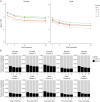Sex Differences in the Role of Multimorbidity on Poststroke Disability: The Taiwan Stroke Registry
- PMID: 38330286
- PMCID: PMC11067697
- DOI: 10.1212/WNL.0000000000209140
Sex Differences in the Role of Multimorbidity on Poststroke Disability: The Taiwan Stroke Registry
Abstract
Background and objectives: Multimorbidity is common in patients who experience stroke. Less is known about the effect of specific multimorbidity patterns on long-term disability in patients with stroke. Furthermore, given the increased poststroke disability frequently seen in female vs male patients, it is unknown whether multimorbidity has a similar association with disability in both sexes. We assessed whether specific multimorbidity clusters were associated with greater long-term poststroke disability burden overall and by sex.
Methods: In the Taiwan Stroke Registry, an ongoing nationwide prospective registry, patients with first-ever ischemic stroke were enrolled; this analysis is restricted to those individuals surviving to at least 6 months poststroke. Using a hierarchical clustering approach, clusters of prestroke multimorbidity were generated based on 16 risk factors; the algorithm identified 5 distinct clusters. The association between clusters and 12-month poststroke disability, defined using the modified Rankin Scale (mRS), was determined using logistic regression models, with additional models stratified by sex. The longitudinal association between multimorbidity and functional status change was assessed using mixed-effects models.
Results: Nine-thousand eight hundred eighteen patients with first-ever ischemic stroke were included. The cluster with no risk factors was the reference, "healthier" risk group (N = 1,373). Patients with a cluster profile of diabetes, peripheral artery disease (PAD), and chronic kidney disease (CKD) (N = 1882) had significantly greater disability (mRS ≥ 3) at 1 month (OR [95% CI] = 1.36 [1.13-1.63]), 3 months (OR [95% CI] = 1.27 [1.04-1.55]), and 6 months (OR [95% CI] = 1.30 [1.06-1.59]) but not at 12 months (OR [95% CI] = 1.16 [0.95-1.42]) than patients with a healthier risk factor profile. In the sex-stratified analysis, the associations with this risk cluster remained consistent in male patients (OR [95% CI] = 1.42 [1.06-1.89]) at 12 months, who also had a higher comorbidity burden, but not in female patients (OR [95% CI] = 0.95 [0.71-1.26]), who had higher proportions of severe strokes and severe disability (p-interaction = 0.04).
Discussion: Taiwanese patients with multimorbidity, specifically the concurrent presence of diabetes, PAD, and CKD, had higher odds of a worse functional outcome in the first 6 months poststroke. Clusters of multimorbidity may be less informative for long-term disability in female patients. Further studies should evaluate other mechanisms for worse disability in female patients poststroke.
Conflict of interest statement
The authors report no relevant disclosures. Go to
Figures


References
MeSH terms
LinkOut - more resources
Full Text Sources
Medical
